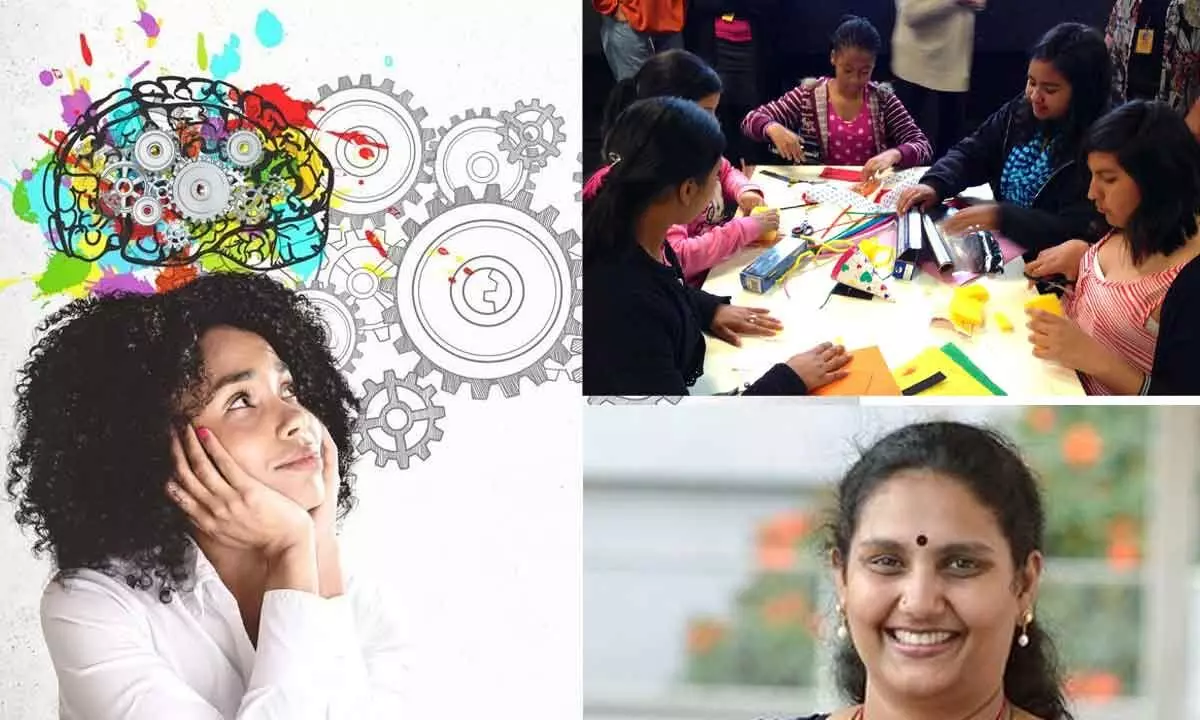Live
- Truck Driver Brutally Murdered in Mulugu District
- Telangana State Cross Country Championship 2024 Successfully Conducted in Kalwakurthy
- Odisha: Collectors asked for proper assessment of crop loss due to unseasonal rainfall
- Woman flyer says Air India left passengers in the lurch in Milan
- ‘Nuvvu Gudhithe’ from ‘Drinker Sai’ is a playful exchange between lead pair
- ‘Marrichettu Kinda Manollu’ gets a grand launch
- Prabhas’ ‘Salaar: Part 1 - Cease Fire’ marks first anniv.
- PKL 11: Puneri Paltan aiming to finish season on high as tribute to their fans
- SEBI takes strict action in front running case, bars 9 entities, seizes over Rs 21 crore
- India-Kuwait friendship to flourish more after elevating ties to strategic partnership: PM Modi
Just In
Innovative design thinking as curriculum


Design - Think Design - Design Thinking
Let's analyse an everyday object. Why are the wheels of any vehicle always circular? Why do we have different application software that almost does the same thing? Why are the objects we interact with on an everyday basis? How different would these objects be if we grow tentacles?
The more significant understanding of the design of any element stems from one perspective-that design must aid a need, and to achieve that, a design must arise from deliberate thought. While the term Design resonates with most of us as an aspect of creativity or art, it also encapsulates skills such as critical thinking, research and collaboration.
A question that arises frequently is, "do we Think Design? Or do we Design Think?"
Of the many problem-solving strategies that exist, Design Thinking is an approach that provides a structured framework to arrive at solutions by addressing unstructured concerns. It provides scope to explore problems through empathy, addressing both qualitative and quantitative aspects of the ideation process across fields.
A simple example of this would be the need for multiple chair designs that essentially serve the same purpose: to support a person while sitting. But, the nuances of the design and thinking are captured by the elements such as where is the said chair designed for. Who are its users? What are the user profiles this design intends to serve? What does this chair become over a period of time- say 200 years?
Take, for example, the 'Adventure series', a GE healthcare launch attempting to solve the need for child-friendly paediatric settings - turning MRI machines from dark cave-like experiences to pirate ships, beaches, sandcastles and the ocean. These are all solutions to a specific problem statement central to the user's needs.
"Using the Design Thinking approach to solve a problem statement demands the problem solver to be mindful of the user's need for the solution and the user's need from the solution. An extensive process in which every puzzle block is treated in its entirety to gauge its worth in the BIG picture, Design thinking is a discipline of thought processes to solve layered problems" says Shobha Sivaramakrishnan, Head of Ekya Learning Centre.
At Ekya, Design Thinking is integrated into the curriculum through Design Thinking workshops for students and educators to solve broad socio-culturally relevant real-world problem statements to allow students to interact with people from varying backgrounds, explore new areas of inquiry, choose their niche of interest within the larger umbrella, explore their specific puzzle piece towards the larger statement and work towards their areas of intervention. A few statements explored in the past are - "How might we make recycling more accessible to citizens of Bengaluru?", "How might we create solutions for the growing garbage problem in Bangalore to improve the life of local citizens."
Students are presented with real-world problems/situations and Engineering design challenges in Science, Makery and Computer Science to encourage students to approach the problem statement through Design Thinking, enabling the process to be viewed as a flexible problem-solving strategy.
To list a few skills that are targeted through these challenges
♦ Challenge assumptions
♦ Accept failure
♦ Be open to criticism
♦ Creative and innovative thinking
♦ Think beyond conventional solutions
♦ Identify user needs by stepping into their shoes
♦ Empathise towards user experience
♦ Oscillate between divergent and convergent thinking during ideation
As we're moving away from traditional classroom environments to more exploratory spaces and resources to engage in learning, Design Thinking comes in as a mindset tool to incorporate flexibility, uncertainty and non-linear thinking to approach the future in education. Moving from inorganic learning methods to embracing experimentation and building holistic, interdisciplinary, creative collaboration in learners and educators, the process may not just be approached as a set of defined steps towards solving rigid problems but as building a frame of mind to approach a situation from multiple perspectives, applicable to other areas of inquiry and innovation, recognising the inherent differences between Design, and Design Think-ing even in everyday conversations.
(The writer is a Head of
Learning, Ekya Schools)

© 2024 Hyderabad Media House Limited/The Hans India. All rights reserved. Powered by hocalwire.com






